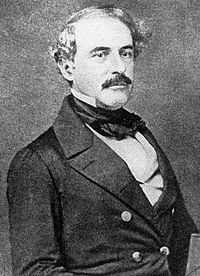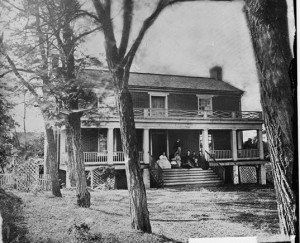One of the most interesting stories to come out of the American Civil War was the arrangement of a site for the formal surrender of Robert E. Lee and his troops. How was the site selected? Who was in attendance at the signing? What became of the structure and furnishings after the war? These are all interesting details you may not have read about.
Thank you for reading this post, don't forget to subscribe!
First, one of the most ironic events in the Civil War concerned the site ultimately chosen for Lee’s surrender. How one man was connected to two of the largest of Civil War events, years apart and at two separate locations, is ironic in the extreme. The details of this along with the arrangements for the surrender of Robert E. Lee are two of the war’s more ironic moments.
The McLean Home
A man named Wilmer McLean had the distinction of claiming that the Civil War started and ended at his home. In a large way he was correct. It so happened that in 1861 McLean had settled at a site known as McLean’s Ford very near Bull Run. The Confederate forces had dug in at Bull Run erecting earth works as a defense of an expected surge of Union troops into the south. McLean’s home was essentially put on ground zero.
On July 18, 1861 a Union shell was fired and amazingly fell into the chimney of McLean’s house. The story is that the shell landed in a pot of stew and exploded. While there were no casualties in the McLean home as a result of the explosion, the event marked the opening salvo of what would be known as the first Battle of Bull Run. This engagement many say was the start of the war.

The Surrender of Robert E. Lee
Now, from the McLean Home that was at Bull Run in 1861, we fast forward to the last days of the Civil War. The setting was now 1865 with Richmond Virginia under heavy Union siege. Jefferson Davis had already fled the Confederate capital and was on the run heading to the Carolinas. Generals Ulysses S. Grant and Robert E. Lee were only a few miles apart.
The surrender of Robert E. Lee came at a time when the war for the Confederates was in utter turmoil. Lee’s army was ragged after months of marching and skirmishes and the lack of an adequate supply line, namely food, was devastating. Without a supply line and the choke hold the Union Army had on the South, Lee had very little choice than to surrender his army to General Grant.
Regarding Wilmer McLean, like many all over the country, he became tired of the war. When the armies retreated he moved to a farm in southern Virginia and resided in a house that fronted a street at Appomattox Courthouse. The house was on a well used stage route and had previously operated as a hotel. It became a single family home after McLeans’s purchase. As history would have it, Appomattox Courthouse would be the site where the Civil War officially ended. This time however, it wouldn’t be shells exploding that brought McLean to the center of events. By fate, it was in this small village that he had chosen to live where the Civil War would touch him again.
Where to Have the Official Signing

When Lee decided that there was no other alternative than to surrender and word of this was sent to Grant, the next question was where would this meeting take place?
McLean was walking in the village when a Confederate soldier approached him and asked where the two opposing generals might meet. McLean showed him a few sites which weren’t satisfactory for a variety of reasons, mostly inadequate furnishings. Eventually, McLean took the soldier to his own home and the site appeared perfect. The two Civil War generals met there afterwards, the surrender documents were signed and McLean’s house in Appomattox Courthouse would reside forever in Civil War History. In a very real way, by simply fate and coincidence, Wilmer McLean was present at both the official start and ending of the American Civil War.
Two additional Trips Into History photo articles you’ll find interesting are the Civil War Submarine and the Confederate Navy.
Preserving Such a Historic Site
At first most people would have assumed that the McLean House would have been carefully preserved for posterity. The fact is that it was and wasn’t. It stood at the same site in Appomattox Courthouse until the year 1893. At that time it was disassembled and brought to Washington D.C. for an exhibition. The people who financed this move however were ruined during the deep Financial Panic of that year and the house was never reassembled. The contractor who had torn it down and shipped it to Washington was never paid. All of the parts were laid out in the open and eventually were deteriorated beyond repair. The famous house would never be put together again.
The Original Furnishings

Not as a surprise, some of the original furnishings in the McLean House appomattox courthouse in 1865″ at the time of Lee’s surrender became quite valuable to collectors. Chairs where Lee and Grant had sat were taken away against the wishes of McLean. Chairs which had cane backing were cut up and sold as mementos. General Philip Sheridan reportedly bought the table where the surrender terms were written up and eventually donated it to the widow of George Armstrong Custer. According to the book, A Terrible Glory by author James Donovan, Brevet General Custer mingled outside the McLean House with Confederate officers he had known from West Point while the surrender document was signed. General Custer and his troops had been involved in skirmishes and victories just a short time earlier around the village. General Ord also purchased the table where the signing actually occurred. That table is now on display at the Chicago Historical Society.
As luck would have it, a man named P.C. Hubard had made very detailed drawings of the house for the contractor before it was disassembled. Hubard’s drawings were then preserved in the Lynchburg Virginia Library. There the drawings stayed for decades. In 1948, just a few years after the end of World War Two, the Federal Government ordered that a replica house be constructed. Hubard’s drawings would be critical for the project. Donations were forthcoming and the state of Virginia appropriated money for the furnishings. The total cost of the project ended up to be just under $50,000.
The dedication of the McLean Home was made in 1950 in the presence of U.S. Grant III and Robert E. Lee IV. The home resides now at the Appomattox Courthouse National Historic Park in Virginia. Also within the Appomattox Courthouse Park is a Confederate Cemetery which is the final resting place for eighteen soldiers killed during the battles of Appomattox Station and Appomattox Court House.The park visitor center shows two different 15 minute videos on an hourly schedule in it’s 70 seat theater.
The Appomattox Court House National Historic Park is located in south central Virginia about 95 miles west of Richmond. If your road travels take you to Virginia, you’ll certainly want to add this very historic site to your trip planner.
(Photos from the public domain)
